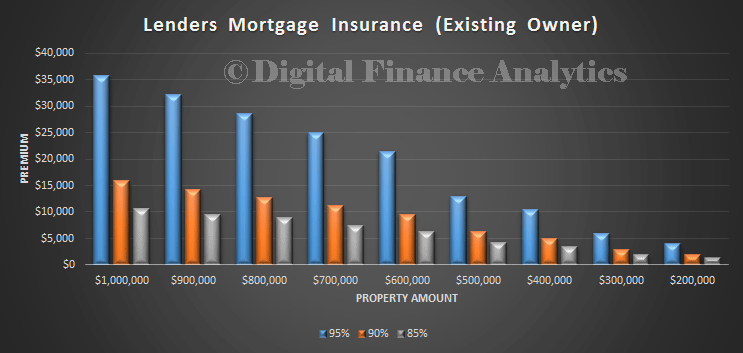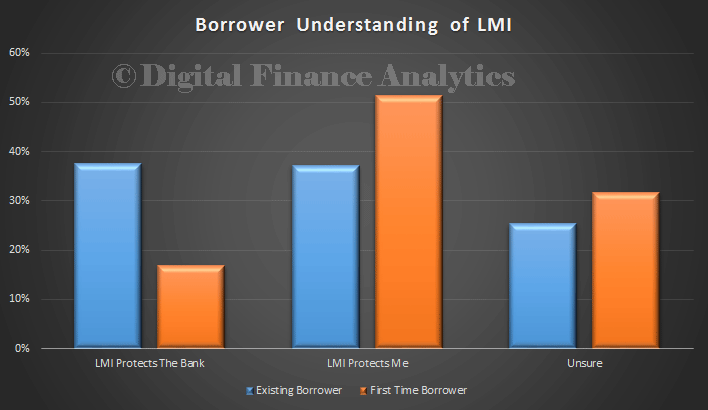
By Martin North, cross-posted from the Digital Finance Analytics blog.
The Australian Mortgage industry has a feature which is relatively unusual internationally speaking. Lenders Mortgage Insurance or LMI is an insurance scheme which protects lender from default by the mortgage borrower. It is not the same as mortgage protection insurance, which is insurance a borrower can purchase to protect against event-like illness or other adverse events. About one quarter of borrowing households have LMI, so it is a substantial market. First time buyers are the most common type of borrower to use it. LMI is not mandated in Australia, but has become normal industry practice for loans above 80%, including investment loans.
Lender Mortgage Insurance is a policy which an insurer will write for a bank, to protect the value above 80% in case of default. Normally the premium, a one off fee on loan draw down, is paid by the borrowers, or added to the loan amount. The premium varies by size of loan, and loan-to-value (LVR). Generally loans above 80% require LMI, and loans up to 95% or more are covered. Loans over $1m, or 100% would require special quotations. The chart below shows a typical premium range for an existing borrower. First time buyers will be charged more. So, for example a loan of $600k, 95% LVR would incur a premium of $21,400 for an existing borrower (3.6%) whereas a first time borrower would be charged $23,800 (4%) for the same facility.
 In our household survey we asked borrowers about their understanding of LMI. First time buyers, in particular, are not clear who benefits from LMI, whereas existing borrowers are slightly clearer that the insurance protects the bank. In the case of foreclosure, the bank would make a claim against the insurer, but it does not stop them also pursuing the borrowers to repay the debt!
In our household survey we asked borrowers about their understanding of LMI. First time buyers, in particular, are not clear who benefits from LMI, whereas existing borrowers are slightly clearer that the insurance protects the bank. In the case of foreclosure, the bank would make a claim against the insurer, but it does not stop them also pursuing the borrowers to repay the debt!
 LMI is either provided by captive insurers within the banks, or by the two major independent insurers, Genworth and QBE LMI. Genworth says:
LMI is either provided by captive insurers within the banks, or by the two major independent insurers, Genworth and QBE LMI. Genworth says:
“Most banks and financial institutions require you to contribute a deposit based on a percentage of the purchase price of your property. With Lenders Mortgage Insurance, lenders may allow you to borrow a higher portion of the purchase price, allowing you to purchase a property sooner and with a smaller deposit than would otherwise be required”.
This is the key benefit, people can borrow more, sooner, because the banks have higher levels of protection. But as Aussie says:
“It’s really important to realise that only the lender is covered by this insurance. It offers no protection to you the borrower”.
Alternatives to LMI are to wait and save up the 20% deposit, or seek a guarantor. Our research indicates that a number of potential first time buyers are exploring these options, because one way or another, LMI costs.
There are a couple of issues we should highlight. LMI is a premium paid, or capitalised into the loan at inception. It is not portable though, so if you switch lenders, or buy a different property, the premium is foregone – unless you ask, and then only sometimes. ASIC’s Smart Money says you might get some of the premium back in the first year or so, but there is no guarantee. It is quite likely you will need to pay again. I have been advocating for truly portable LMI facilities for a few years now.
The other factor to consider is that the LMI Insurers have concentrated risks in their portfolios, so if there were a major downturn, and claims rocketed, they may have issues, just like the US had post 2007. The rating agencies are watching the insurers, and some were downgraded because of the risks implicit in the business. LMI Insurers also provide enhanced support to securitiation deals, which again enhances their exposure to risk. APRA, who regulates the LMI’s insists that the LMI business is structured as a monoline insurer, so that the systemic risks in LMI are not cross linked to broader insurance categories. With such potentially concentrated risks, will they be there if property prices fell significantly?
LMI’s may introduce additional credit cycle risks. The RBA Stability Review in September 2013 discussed the LMI industry. They said:
“The use of mortgage insurance will not necessarily moderate the amplitude of the housing credit cycle, however. Lenders may respond by relaxing standards because they believe the LMI is assessing the risk – an unintended consequence of having a ‘second set of eyes’ – or because they believe that any loss is an LMI loss”
They also make the point that:
“Mortgage insurance is available in many jurisdictions but extensively used in only a small number, including Australia, Canada, Hong Kong, the Netherlands and the United States. The structure of the mortgage insurance industry across these and other countries varies considerably and is affected by the domestic regulatory landscape and the extent of government participation in each jurisdiction.”
So, overall, whilst LMI may allow some to access the property markets sooner, and protects the banks from risk of loss, borrowers are paying for this insurance, and if borrowing more than 80% they will have no choice as this is industry practice.
There are systemic risks to LMI, and there is some consumer confusion about the role of LMI. The fact LMI is generally not portable is problematic.
In my view, LMI is at least partly responsible for the lofty property prices in Australia, and it lifts the cost of entry into the market and if capitalised increases loan amounts on which interest is paid. It is also a barrier to switching. Therefore, the role of LMI should be reviewed as part of any wider property or banking inquiry.

